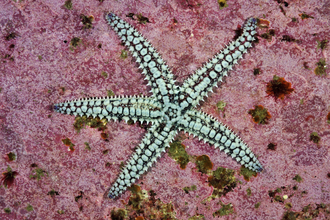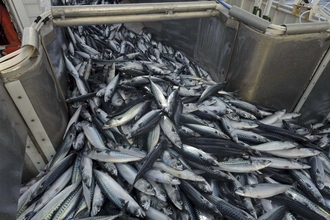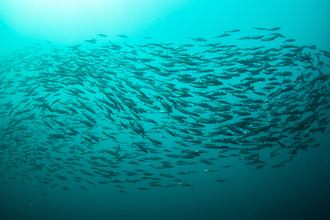Marine conservation and The Wildlife Trusts
The Wildlife Trusts are the biggest marine non-governmental organisation in the UK. Here are some ways we're helping our living seas.
Explore our work on:
Our work on fisheries
Locally, many Wildlife Trust marine staff sit on Inshore Fisheries Conservation Authorities, as marine conservation experts. They help to advise on appropriate local fisheries management methods.
More about how we're working on fisheries
Cumbrian Creel Project
This project is working with local fishermen to diversify away from destructive bottow-towed trawling.
In July 2019, management measures implemented in the West of Walney Marine Conservation Zone prohibited the use of bottom-towed fishing gear, such as trawls, from most of the site. The project is exploring other, more sustainable fishing methods to target the same species within protected areas.
By supporting creel fishing, we not only help our local small-scale fishermen to adapt to the challenging economic climate - we also protect the seabed from damaging trawling. A win for wildlife and for communities!
Encouraging good seafood choices
Each year Cornwall Wildlife Trust produce the Cornwall Good Seafood Guide. The guide advises consumers where to buy sustainable local seafood and how to cook it.
Inspiring people about our seas
Wildlife Trusts across the UK, Isle of Man and Alderney work to inspire people about the wonder of our underwater wildlife!
Explore our events around the coast, from rockpool rambles to snorkel trails to talks about marine life, including during National Marine Week, or dive into some incredible projects from local Wildlife Trusts.
Cornwall Wildlife Trust's Your Shore Network
Your Shore Network is an incredible community of 18 local marine conservation groups in Cornwall. They bring people together to take action for Cornwall's coast and sea through:
- skills development
- research
- community-driven initiatives
- behaviour change
These groups run events including beach cleans, rockpool rambles, sea watches and snorkel safaris, and contribute a huge amount of data to citizen science projects! Their work supports our understanding of the importance of our marine and coastal area and our ocean's help. Over 73,000 people have been reached by the Your Shore Network.
The Bay Project
This nature and wellbeing projects offers people lviing in Morecambe Bay the opportunity to get outside and connect with nature through a range of activities.
Morecambe Bay, like many coastal communities in the North West of England, has been impacted heavily by loneliness and isolation. By taing part in activities like beach cleans, nature walks and rockpooling, as well as learning new skills participants connect with other people and take action for nature.
This project is a partnership between The Wildlife Trust for Lancashire, Manchester and North Merseyside, The Eden Project, Cumbria Wildlife Trust and Lancashire and South Cumbria NHS Foundation Trust.
Scottish Wildlife Trust's Snorkel Trails
Scottish Wildlife Trust's snorkel trails lead snorkelers around special sites around the country, showcasing the amazing diversity of Scotland's seas!
From small sea squirts, sponges and anemones to dolphins, whales and basking sharks, there's a whole world to explore.
Supporting the next generation of marine conservationists
Wildlife Trusts work with schools - online, in classrooms and on the shore - to help teach children about our seas.
For example, Devon Wildlife Trust’s Wembury Marine Centre offers year-round bespoke sessions to connect children of all ages with the sea. The Trust’s Marine Wildlife Champions project also offers schools and educational groups the opportunity to work with marine engagement staff for a full year on a range of marine conservation topics.
The Marine Futures Internship
The Marine Futures North West Internship programmes gives candidates interested in a career in the marine environmemnt to gain skills, knowledge and experience across a variety of marine sectors.
Working across the North West Wildlife Trusts, The Crown Estate, Natural England and Ørsted, each partner organisation provides opportunities for the intern to develop skills in specialist areas including:
- marine conservation advice
- sustainable fisheries
- renewable energy development
- marine policy
- community engagement
Over the past few years, interns have had the opportunity to research key topics including:
- the feasibility of creeling for nephrops in West of Walney MCZ
- cormorants rooting on offshore wind turbines
- nature inclusive design within offshire wind farms
- marine net gain
- kittiwake nesting on offshore substations
- feasibility of seagrass restoration in the Walney Channel
Surveying
Wildlife Trusts and dedicated volunteers across the UK, Alderney and Isle of Man are helping discover and document the amazing marine life around our coasts, and the threats to them. From marine mammal watches to acoustic seabed surveys to litter counts, our staff are always busy out on the coast! We also work with partners on marine research projects - like our world-first Blue Carbon mapping project.
Shoresearch
Our citizen science programme sees dedicated trained volunteers identifying and recording wildlife on our shores.
The data collected helps monitor our fragile sea life and understand the effects of pollution, climate change and invasive alien species. Shoresearch data has been key to designating many of our Marine Conservation Zones!
Seasearch
Many Wildlife Trusts are involved in this project for volunteer divers and snorkelers. The aim of Seasearch is to record marine habitats and species and use the information to help identify sites of special conservation concern.
Restoring coastal habitats
Wildlife Trusts are helping bring our coasts back to life. From seagrass to saltmarsh, we’re aiming to reverse decades of decline by restoring lost coastal habitats.
For example:
- Hampshire and Isle of Wight Wildlife Trust’s undertaking seagrass restoration at scale within the Solent.
- Cornwall Wildlife Trust are pioneering methods for restoring dwarf seagrass in Trust’s Fal Ruan nature reserve. The project aims to identify effective low-cost methods of restoration for the intertidal seagrass species, with the long-term goal of using selected restoration methods for intertidal seagrass beds across Cornwall, where they were once historically found.
- Essex Wildlife Trust is giving saltmarshes a helping hand, installing “saltmarsh sausages” to encourage sediment to build up and vegetation establish.
- Yorkshire Wildlife Trust are restoring native oyster beds in the Humber. To date, the Trust has reintroduced 3,000 oysters to Spurn Point, proving native oysters can once again survive in the Humber estuary.
- Sussex Wildlife Trust and partners are helping restore almost 200 square kilometers of lost kelp forest with the Sussex Kelp Recovery Project.
Advising on developments
Our seas are incredibly busy spaces with huge ambitions to increase development, particularly to achieve net zero by 2030 with large scale offshore wind farm development.
The Wildlife Trusts have engaged for many years in advising on offshore development at the policy and casework level. In particular, we have engaged extensively in offshore wind farm development and have contributed to 18 offshore wind farm planning applications in the past 10 years.
We are working across government and with regulators, statutory nature conservation advisors, and industry to influence future policy that has nature recovery at the heart of all future planning decisions.
Campaigning for effective Marine Protected Areas
Our seas are damaged and degraded, but science shows us that by removing pressures, marine wildlife can bounce back and recover. The Wildlife Trusts have been campaigning for Marine Protected Areas for many years.
England
In 2001, almost 250,000 people supported our Petition Fish campaign which led to the Marine and Coastal Access Act being passed to designate Marine Conservation Zones in England and better protect our seas.
Since then, our campaigning has supported the introduction of 89 Marine Conservation Zones in England. Our supporters have been integral in helping us secure these vital protections. For example, in 2018 over 22,000 people signed our Wave of Support campaign within just 6 weeks to support the designation of 41 Marine Conservation Zones.
More recently, we have been campaigning for Highly Protected Marine Areas (HPMAs) – the gold standard of protection for our seas, designated to enable marine ecosystems to recover. Joan Edwards OBE, our Director of Policy and Public Affairs, sat on the Government’s advisory panel tasked with reviewing whether and how HPMAs could be introduced. Our campaign in 2020 was supported by 10,000 of our supporters and lead to the Government saying yes to introducing these special sites. Since then, over 17,000 people backed our call asking the Government to designate the first Highly Protected Marine Areas in the UK. This led to the first three Highly Protected Marine Areas being designated in England in 2023.
While decades of advocacy and campaigning have led to a network of Marine Protected Areas being designated, unfortunately many of these are not well managed and monitored. Damaging activities such as fishing, developments and pollution are still allowed within many of their boundaries, leading them to be damaged and degraded. We are continuing to call on the Government to properly protect Marine Protected Areas, for the benefit of wildlife, people and climate.
Wales
Welsh Seas double the size of Wales, that’s right Wales has more sea than land. Therefore, it’s critical that we protect the amazing wildlife in our waters. To achieve this Wales has designated 139 MPA’s. But these sites aren’t being effectively managed and often we don’t know the extent nor the condition of the special features that the MPA was designated for.
By 2030 Wales has committed through the UN Biodiversity Conference COP15 e.g. to effectively manage at least 30% of Wales’ seas for nature by 2030. We welcome this but this must be achieved within already existing commitments to manage 139 of MPAs in Welsh waters to form an ecologically coherent network of protected sites in Welsh seas. Furthermore, at least 10% of these area’s should be within areas fully protected (no extractive or destructive activities are allowed, and all impacts are minimized) by 2030. However, presently only 3% of Wales MPA’s have all their features (habitats within the MPA) that are effectively managed. So, it's clear we need to invest in more action, at scale and at pace.
Managing sites:
There are three coastal Trusts, North Wales Wildlife Trust (NWWT), Wildlife Trust of South and West Wales (WTSWW) and Gwent Wildlife Trust (GWT). They manage 34 coastal reserves that cover the coastal habitats of rocky foreshore, salt marsh and intertidal mudflat, including the islands of Skomer and Skokholm.
Engaging People:
Living Seas Wales, run by NWWT and WTSWW, has been an impactful and effective project to engage Welsh people with their incredible coastline, engaging over 17,500 people with its messages, developing citizen science, achieving 12,950 hours of volunteer effort equating to over £92,500 of time.
Citizen Science:
Running across the UK, Shoresearch is a Wildlife Trust citizen science project involving committed volunteers collecting scientific data on marine plants and animals on the intertidal shore. This includes recording species on rocks and taking a sand and mud core sample.
Restoring Seagrass:
Partnering with Swansea University, the charity Project Seagrass and WWF-UK, the Wildlife Trusts are restoring this value wildlife and carbon habitat. The UK has lost up to 90% of its seagrass meadows in the past century; this collaboration to begin to restore some of what we have lost.
Working in partnership:
The Wildlife Trusts are working with Natural Resources Wales (NRW- the statutory nature conservation body in Wales) to support their work on the MPA network, including offering advice on the new off-shore marine sites known as Marine Conservation Zones (MCZ’s). They are also part of the Wales Coasts and Seas Partnership (CaSP Cymru); which focuses on ocean literacy, sustainable investment and capacity building.
Cardigan Bay Marine Wildlife Centre:
Undertake boat surveys to gather valuable information on the local bottlenose dolphin population as well as other species encountered. They work in conjunction with Ceredigion County Council, with volunteers manning the New Quay harbour survey site for the council’s Dolphin Watch Project and supporting university students to collect data.
Future Fisheries:
The aim of the project is to champion a low-impact, profitable fishing industry in Wales where marine wildlife also thrives. The project seeks to increase people’s understanding and appreciation of the marine environment as well as the range of activities and pressures the marine environment faces.
Fishing Gear Assessments:
The impacts of fishing activities in MPA’s is required under the Habitats Directive. The Assessing Welsh Fisheries Activities project started in 2018, and while the ‘purple assessments’ (those considered high risk) have been completed by NRW, no action has been implemented by Welsh Government.
Scotland
Scottish Wildlife Trust work closely with Scottish Environment LINK to progress policies that support marine protections in Scotland. The LINK Marine Group, which has been running since 2007, has a vision of healthy, well-managed seas, where wildlife and coastal communities flourish and ecosystems are protected, connected, and thriving.
In 2010, the LINK marine group played an integral part in securing new marine governance, conservation and planning through the Marine (Scotland) Act 2010, including duties to enhance the marine environment, establish a National Marine Plan and develop a network of Marine Protected Areas.
37% of Scotland’s seas are currently within Scotland’s MPA network, and the Scottish Wildlife Trust will be working towards the development of fisheries management measures for this network, as well as priority marine features not currently covered by the MPA network. LINK members helped successfully make the case for a Scottish Future Fisheries Management strategy which acknowledges need for ecosystem-based fisheries management and additional protections for important areas for fish. They strengthened proposed MPA fisheries management measures through their ‘Don’t take the P’ campaign.
A highly protected marine areas consultation was held in 2023 and is not being progressed as consulted following negative feedback from the fishing sector and coastal communities. However, 55% of responses were in favour of HPMA’s, largely as a result of the Save Scotland’s Seas e-action campaign run by the LINK marine group.
A national marine plan was adopted in 2015 with a consultation on a new national marine plan 2 currently in consultation. The Scottish Wildlife Trust are calling for a plan that puts ocean recovery at the heart of decision making, that recognises the twin threats of climate change and biodiversity loss. The Scottish Wildlife Trust works directly with the NMP2 team to feed back opinions from local coastal communities, using workshops that feature their oceans of value film to discuss marine planning and how to protect the marine environment.
Northern Ireland
Over the past three decades a network of MPAs has been designated in Northern Ireland. Guided by the five OSPAR principles, the MPA designation process prioritizes features in decline, at risk, or particularly sensitive. The principles emphasize representativity, connectivity, resilience, and effective management to create an ecologically coherent MPA network. Such a network ensures the protection and conservation of marine biodiversity while fostering connectivity between ecosystems. Ulster Wildlife campaigned for the designation of these sites through public awareness events and working with policy makers.
Northern Ireland boasts a network of 48 Marine Protected Areas (MPAs), covering a substantial 38% of local waters. The MarPAMM project led by the Agri-Food and Biosciences Institute (AFBI) made progress toward creating management plans for many MPAs. The Department of Agriculture, Environment and Rural Affairs (DAERA) are currently working to review the network of sites. At Ulster Wildlife we advocate that the priority should be to enhance ecological connectivity across the network, as emphasized in the JNCC 2018 assessment.
The Northern Ireland Marine Task Force (NIMTF), a coalition of non-government environmental organisations, lead a campaign “Act Up” in 2011 that resulted in 4000 letters from members of the public to MLAs calling for a strengthened Marine Bill which would in turn lead to the Marine Act in 2013. The campaign wanted to ensure that activities within the marine environment were assessed properly, leading to the development of a new governmental marine division for co-ordinated marine activities.
In 2013, the Marine (Northern Ireland) Act mandated DAERA to establish a MPA network in the inshore region and develop marine plans within the framework of the UK Marine Policy Statement.
In 2016, Northern Ireland designated 4 inshore Marine Conservation Zones, Rathlin, Waterfoot, Outer Belfast Lough, and Carlingford Lough. NI has 5 in total, as Strangford Lough automatically became an MCZ from having been a ‘Marine Nature Reserve’ at the time under the Wildlife and Countryside Act (1981).
In 2020, NIMTF engaged on the development of management plans for the designated MPA Network to ensure that effective management measures were in place for NI Priority Marine Features (PMFs) across the network; building on the work put in place for the Draft NI Marine Plan in 2018. The engagement on these management plans was part of the MarPAMM Project, which would go on to develop regional MPA Management Plans across the network.
Currently, the Northern Ireland MPA network comprises 6 Special Areas of Conservation (SACs), 9 Special Protected Areas (SPAs), a proposed SPA, an area of Special Community Interest (SCI), 5 Marine Conservation Zones (MCZs), and 2 offshore MCZs, reflecting the transboundary nature of MPAs in the Irish Sea.
Additionally, 7 Ramsar sites with marine aspects and 18 Areas of Special Scientific Interest (ASSIs) contribute to Northern Ireland's MPA network.
The only feature habitat not currently represented in the NI MPA network are Native Oyster Beds, whilst concerns remain on the levels of replication of species and habitats across multiple protected areas. Ulster Wildlife currently have an initiative to restore and protect native oysters using nurseries that have the potential to contribute to overall network connectivity and help restore this important habitat in Northern Irish waters.
The diverse array of MPAs, including SACs, SPAs, MCZs, and Ramsar sites, underscores the region's comprehensive approach to conservation. However, gaps remain in the MPA network and efforts must be made to increase its ecological coherence, connectivity and ensure that the measures contained within management plans are effective and are enforceable.
Isle of Man
The Isle of Man Government Department of Environment, Food and Agriculture (DEFA) manage ten designated marine nature reserves (MNRs) covering 10.8% of total Manx waters and 51.8% of their 0-3nm marine territory. The first established of the reserves, Ramsey Bay, was designated in 2011 and protects an area of 94.5km2.
The MNRs were established to afford greater protection to important and vulnerable habitats and species considered to be priorities for conservation under International conventions. They help to support sustainable fishing practices, allow recovery of habitats and facilitate recolonisation of native species.
Horse mussel reef, maerl beds and sea grass meadows are just some of the valuable habitats protected, which are some of the most ecologically diverse and productive ecosystems in the world, providing food and shelter, particularly for juvenile fish species and scallops and capturing and storing atmospheric carbon dioxide.
Practices not permitted in Manx MNRs include, netting, long-lining, aggregate extraction, littering or construction, as well as destructive fishing processes such as dredging and trawling.
Manx MNRs are protected by the Wildlife Act 1990 and IOM Marine Policy, through development of the Manx Marine Nature Reserve Project, ‘Future Fisheries’ strategy, Biodiversity strategy and international treaty objectives. They are monitored and managed by the Isle of Man Government Department of Environment, Food and Agriculture (DEFA), with support from Manx Wildlife Trust.
In future, DEFA hope to extend their protected areas to include the 3-12nm zone around the Island, which is not currently protected, leaving it vulnerable to damaging practices such as unsustainable fishing and marine developments.
For more information about Manx Wildlife Trust and their MNRs, please visit Marine Nature Reserves | Manx Wildlife Trust (mwt.im)
Alderney
Alderney Wildlife Trust (AWT) are administrators of the Island’s West Coast & Burhou Islands Ramsar Site on behalf of local government, the States of Alderney. The AWT coordinates and implements long-term management strategies and annual action plans. These aim to promote the wise use of the site, engage with the local community and conserve its internationally important marine life. This includes monitoring the designating features; Northern gannet (Morus bassanus) population and other important seabird species, including the Atlantic puffin (Fratercula arctica), and water fowl conservation projects including Ringed Plover nest cordons. In addition, a range of marine species population assessments are undertaken within the site, including grey seal, green ormer (Haliotis tuberculata) and rocky shore crab species. Fish species are monitored through baited drop-down video surveys, Seasearch and more recently through the FishIntel Project. Over the next few years, the AWT aim to focus on defining subtidal habitat features using drop-down video and side scan sonar equipment, to better understand the undersea landscape of the Ramsar Site.











